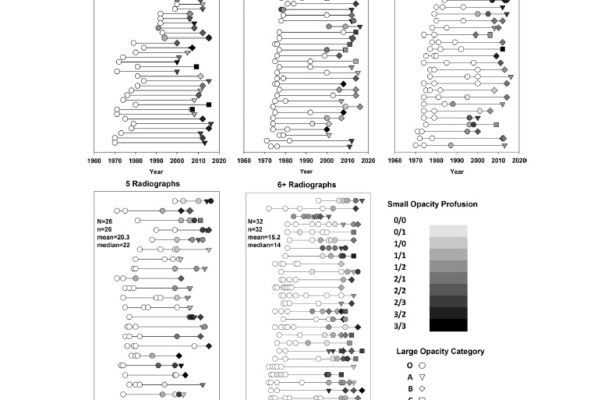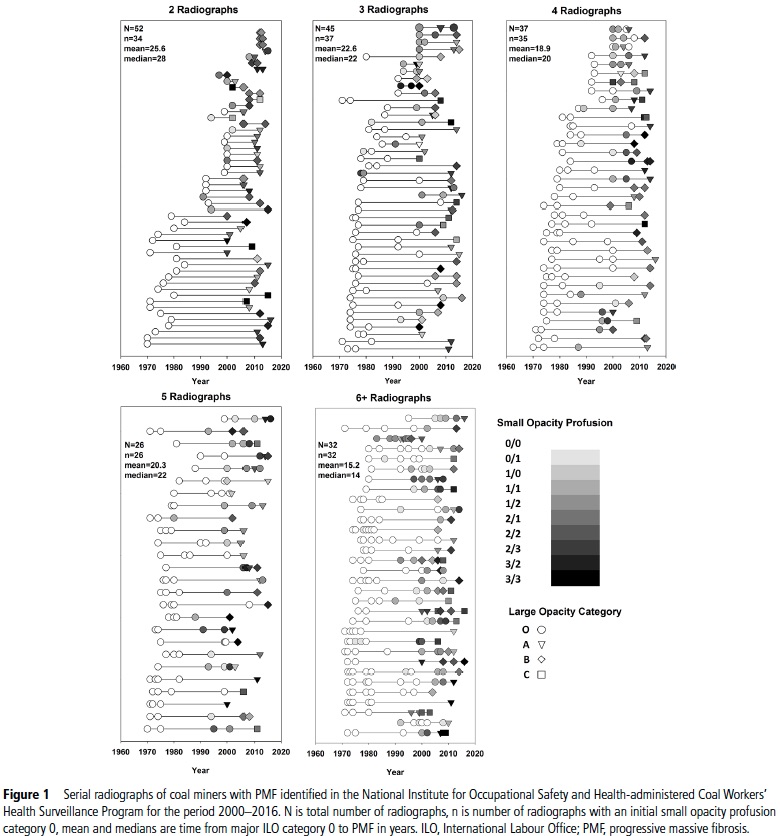Study on Progression of Severe Black Lung Shows Disease Not Being Detected Soon Enough Due to Infrequent X-rays of Coal Miners

Researchers are trying to better understand the resurgence of severe black lung among American coal miners.
A study—”Radiographic Disease Progression in Contemporary US Coal Miners with Progressive Massive Fibrosis” (available online here, downloadable here, and embedded below)—was recently published by the peer-reviewed journal Occupational and Environmental Medicine.
In this study, NIOSH epidemiologists looked at data from the Coal Workers’ Health Surveillance Program to better understand how complicated coal workers’ pneumoconiosis is progressing in those coal miners who have it.
In specific, the researchers identified 192 coal miners with the advanced form of coal workers’ pneumoconiosis called progressive massive fibrosis (PMF) who also had at least one prior x-ray. As the name of the disease suggests, progressive massive fibrosis is a progressive disease that often gets worse over time. The basic idea of the study was to look at miners who have the disease and then look back at their prior x-rays to determine how the disease progressed.
The 192 miners in the study worked in 8 different states, but the vast majority (84.4%) worked in the central Appalachian states of Kentucky, West Virginia, and Virginia during at least part of their career. 88% worked underground exclusively, 4.2% worked exclusively on surface mines, and 7.8% worked on both.
The chart above show the progression by the number of x-rays. The white circles are normal x-rays while the other shapes show PMF. Because the length of the line represents the length of time between x-rays, the miners who have short lines between their white circles and polygons represent 1 in 7 miners in the study who went from having a clear x-ray to the severe form in less than a decade.
A few findings stand out:
- “The mean time from the most recent normal radiograph to a radiograph with a determination of PMF was 20.7 years (median 20; range 1–43).”
- “Of these 163 miners [who had a normal x-ray at one point], 27 (16.6%) progressed to PMF in less than 10 years, 57 (35.0%) progressed to PMF in 11–20 years and 79 (48.5%) miners progressed from normal to PMF in more than 20 years.”
- “Alarmingly, 27 (14.1%) rapidly progressed from normal to PMF in less than 10 years.”
And as the authors note, these numbers likely do not capture the true severity of the disease. “The estimates we report of time from a normal radiograph to PMF are inherently biased and underestimate the true rate of progression.”
The cause of the disease is familiar: “Cochrane et al put it succinctly in the 1960s by concluding: ‘three factors—age, mining, and hard work—are likely to affect the progression rate’ to PMF.”
Other than being another important reminder of the severity of black lung among modern American coal miners, the study also offers some lessons regarding the need for more outreach and monitoring of the disease.
The study says that the miners who got more x-rays were more likely to catch the disease earlier. For the miners who got 6 x-rays, PMF was found 14 years after the normal x-ray. In contrast, for the miners who only had 2 x-rays, their PMF was first detected 28 years after the normal x-ray. This is important because it appears that coal miners who are not getting x-rayed frequently, may not have their black lung caught for twice as long. This lack of medical information about what’s happening in miners’ lungs keeps these miners with black lung from being able to protect themselves and get the treatment they need before their disease becomes life threatening.
NIOSH recommends “that all miners participate in spirometric and radiographic surveillance at 5-year intervals throughout their working career.”
The study’s authors also acknowledged that the government’s surveillance program did not detect the disease in many working miners.
It is likely that some miners in this study worked for years with severe lung disease that went undetected by our surveillance programme until they participated close to or after retirement. It is also now clear that there are a significant number of miners who have worked for years with severe lung impairment that have gone undetected by our surveillance programme altogether.
As NIOSH and others are working to better understand and stop the resurgence of black lung, this study provides useful information on the progression of severe black lung and the need for regular x-rays of coal miners to catch the disease at its stages.
The citation for this article is A. Scott Laney, et al., Radiographic Disease Progression in Contemporary US Coal Miners with Progressive Massive Fibrosis, 74 Occupational & Environmental Medicine 517 (2017).
A. Scott Laney, et al., Radiographic Disease Progression in Contemporary US Coal Miners with Progressive Ma… by AppCitizensLaw on Scribd
